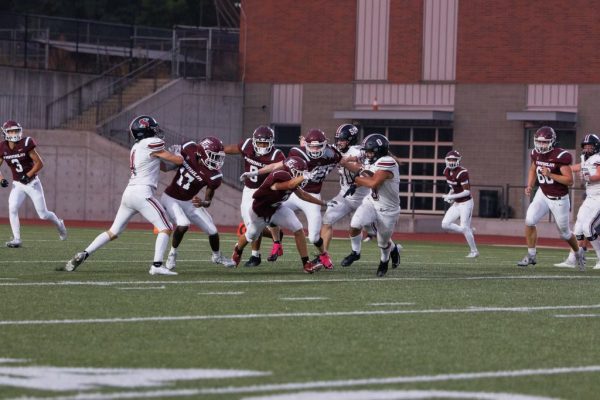
Starting in 2021, the National Collegiate Athletic Association (NCAA) allowed Name, Image, and Likeness (NIL) to be used by collegiate athletes. NIL was introduced to give NCAA student-athletes the opportunity to sign brand deals with interested companies. However, with the NCAA essentially allowing universities to pay student-athletes to attend their school through brand deals and other marketing, NIL opened up many new opportunities that had been previously unavailable to college athletes for all of the NCAA’s existence. Since this transition to using NIL, college sports have never been the same, and this change could be coming to high schools soon as well.
NIL has completely transformed how the NCAA operates. Pre-NIL, universities were not allowed to offer recruits any sort of offer that involved money. When coaches recruited, they focused more on pitching qualities of their team and university to potential athletes, rather than giving their best offer financially. Now, when it comes to recruiting, universities almost have to out bid each other to get the players that they want. These offers can reach up to seven figures.
It hasn’t taken long for NIL to trickle down into the everyday lives of high school student-athletes. NIL is currently allowed in 39 states for high school student-athletes, however, according to the Business of College Sports, its usage is limited in some states that have specific rules and guidelines players have to follow in order to qualify for NIL deals. Here in Oregon, there are no restrictions when it comes to student-athletes making NIL money. Since NIL is outlawed in 11 states, high-level athletes in these states have to make a tough choice of whether or not to transfer into a school in a state where NIL is allowed if they want to gain the benefits of NIL.
When scrolling through the comments of a top tier recruiting site, such as On3 or 24/7Sports, you may notice a lot of criticism from high school athletics fans that claim NIL has hurt the integrity of high school sports. Transferring schools for sport related reasons is not a new occurrence, but with NIL in play, it changes some of the motivations for why student-athletes would want to transfer to schools with nationally recognized teams. These more prestigious teams garner more national attention and, as such, athletes on these teams have greater potential to get NIL deals. Current quarterback at the University of Nebraska, Dylan Raiola, is a good example of a student-athlete transferring for their sport. Raiola, during his high school career, attended three different high schools, all with football being his main reason for transferring. The main reasons student-athletes transfer is to improve their brand and be more recognizable to both colleges and the general public.
Although, since NIL is allowed in Oregon, athletes are not transferring out of state to access NIL, that isn’t to say Oregon high schools don’t have to deal with some of the ramifications of NIL. One common trend for high school student athletes in Oregon is transferring to athletic prep schools. A prep school’s purpose, in relation to athletics, is to recruit elite level high school talent and create sports teams full of those players. The school’s entire pedigree revolves around its sports teams, with things like online classes being used to help student-athletes spend as much time as they can at their sport. These prep schools are able to recruit such talented athletes because they are able to mention the national recognition that comes with playing on these teams. This prestige can not only help student athletes gain attention from colleges, but also recognition from companies looking for athletes to advertise.
I talked to the head football coach of Jesuit High School, Ken Potter, and he explained how he believes that NIL plays a big role in student-athletes’ decision to transfer to prep schools. “I think that [student-athletes are] reading about how much money people are making, and so they’re thinking that that would be the way they’d want to go.”
Controversy aside, NIL has helped certain student-athletes make a little cash while enjoying their high school experience. Portland’s very own Jackson Shelstad was the first high school student-athlete to sign an NIL deal in Oregon with his signing to Portland Gear, a Portland based apparel company.
It’s important to know that as of right now very few high school student-athletes have signed NIL deals. However, in the years since NIL has passed, more and more deals are being signed, so it can only be assumed that this trend will continue and NIL is going to be an even bigger part of teenage athletes’ high school experiences soon.
The debate on whether or not NIL belongs in high school sports is very controversial, especially in regards to if its benefits will be able to be felt by all talented high school athletes. Potter explains that the addition of NIL to the high school level has been a bad decision because it makes great teams become even better. “ I just think that the rich get richer … it’s becoming a situation where there’s not as much equality, and many students are trying to get more money out of [high school] than getting an education.”
Jon Eagle, the head football coach at West Linn High School, didn’t agree with the old rules regarding NIL, however, he believes it needs to be limited in some capacity. “It was okay for a coach to climb the ladder and get a better job that paid more, but it wasn’t okay for the players,” Eagle says. “So I think that [NIL is] moving in the right direction, however, I do think that they’re going to have to make some kind of change … on the system because I don’t think it’s sustainable in the long term.”
Whether you agree that NIL belongs in high school athletics or not, it’s important to understand what it is and how it will impact future generations. There’s a lot of unknowns about NIL, but one thing about it is clear: it’s here to stay and teenagers around the country are and will have to embrace it.



































Jodi • Oct 13, 2024 at 9:39 pm
Excellent article. Thank you for explaining NIL and all of it’s complicated details.